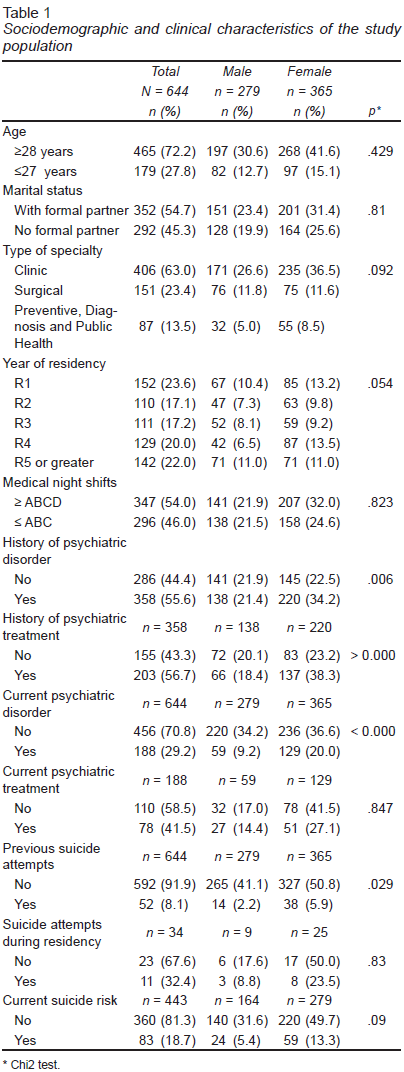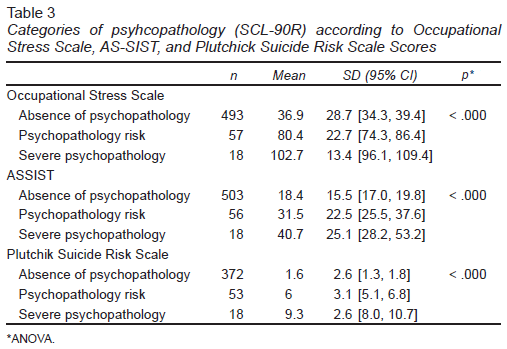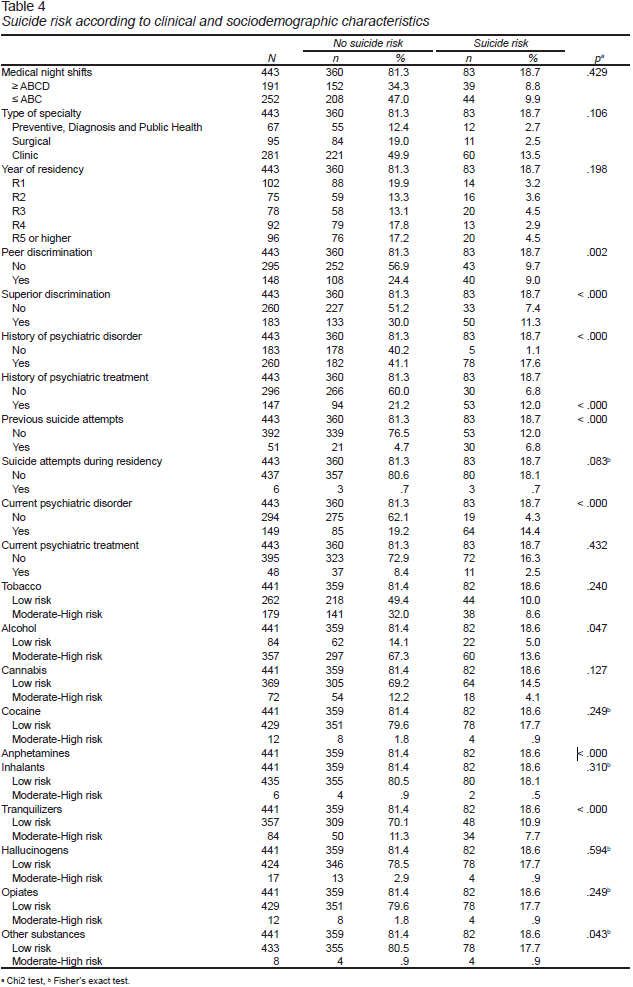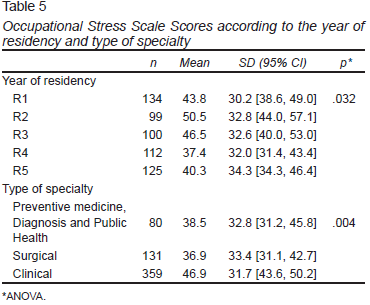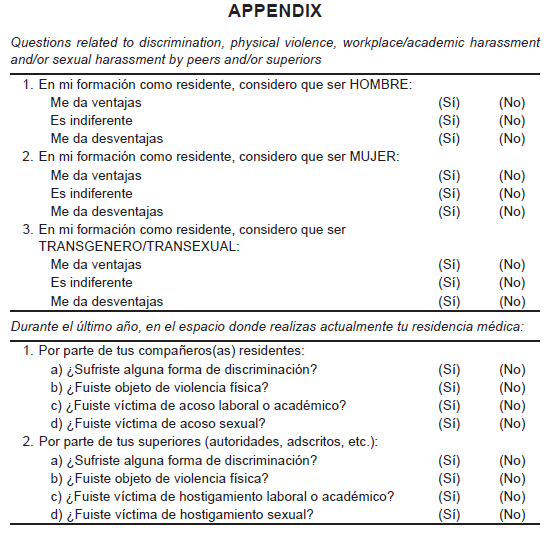Introduction
Mental health disorders are an emerging problem in resident doctors due to conditions such as stigma, work environment, academic requirements, and the complexity of medical care. Some studies indicate that the prevalence of burnout increases throughout training (Becker, Milad, & Klock, 2006; Dyrbye et al., 2014; Dyrbye & Shanafelt, 2016), and may be higher than in other university degrees (Shanafelt, Sinsky, Dyrbye, Trockel, & West, 2019). Residents are exposed to a high workload, academic pressure, peer competition, discrimination based on sex, age and academic rank, lack of sleep, fatigue, interpersonal conflicts, and inability to meet personal needs; factors that have been associated to occupational stress and the onset of psychiatric disorders (Romo-Nava et al., 2019; Veldenz, Scott, Dennis, Tepas, & Schinco, 2003).
Some studies have reported a higher prevalence of psychopathology among doctors compared to the general population (Melo-Carrillo, Van Oudenhove, & Lopez-Avila, 2012; Romo-Nava et al., 2019; Schwenk, Davis, & Wimsatt, 2010; Dyrbye, Thomas, & Shanafelt, 2006; Quince, Wood, Parker, & Benson, 2012), where depression, anxiety (Olagunju, Ogundipe, Lasebikan, Coker, & Asoegwu, 2016), substance use (Cottler et al., 2013), and suicidal risk prevail (Dutheil et al., 2019). As a consequence, poor academic performance, attrition, deterioration in patient care, and suicide are documented (Coentre & Figueira, 2015; Coentre, Faravelli, & Figueira, 2016; Dyrbye et al., 2006; Quince et al., 2012). In medical students and resident physicians, the prevalence of depression and anxiety has a wide range (Jiménez-López, Arenas-Osuna, & Angeles-Garay, 2015; Melo-Carrillo et al., 2012; Romo-Nava et al., 2019). In the United States, a prevalence of depression of 48.5% is reported, while in the United Kingdom it goes from 5.7 to 10.6%, depending on the academic year (Romo-Nava et al., 2019). In Mexico, reports in resident medical units range from 25% to 79.6% for depression and 39% to 69.9% for anxiety, with the highest prevalence in second year residents (Jiménez-López et al., 2015). Likewise, a systematic review that included 17,560 residents, found that 28.8% had depression (range 20.9% - 43.2%) (Mata et al., 2015); while a study published in 2019 reported a prevalence of depression of 16.2% (Romo-Nava et al., 2019). Among physicians, the life time prevalence of alcohol and illegal drug use shows similar levels to those in the general population (10-12% versus 7-15%, respectively) (DuPont, McLellan, Carr, Gendel, & Skipper, 2009; Elliot, Tan, & Norris, 2010). Among the substances of higher consumption are alcohol, tobacco, and marihuana, followed by prescription drugs such as opiates and benzodiazepines (Martínez-Lanz, Medina-Mora, & Rivera, 2005). Suicide is a public health problem accountable for many deaths annually worldwide. The suicide rate in doctors, particularly female physicians, is higher than the general population (Center et al., 2003; Gold, Sen, & Schwenk, 2013; Jin & Guo, 2018; Mingote Adan, Crespo Hervás, Hernández Álvarez, Navío, & García-Pando, 2013). Furthermore, it is considered the only cause of death with higher prevalence among doctors than the general population (A’Brook, Hailstone, & McLaughlan, 1967; Dutheil et al., 2019). A prevalence of 12% of suicidal ideation has been reported in residents (van der Heijden, Dillingh, Bakker, & Prins, 2008; Jiménez-López et al., 2015). Suicide is mostly related to untreated mental disorders, psychosocial stressors, access to prescription substances, and knowledge of their lethal doses (Gold et al., 2013; Jin & Guo, 2018). The lack of recognition of a mental disorder and the stigma that comes with suffering from it within the medical profession is related to an inaccurate self-diagnosis, self-medication, and lack of attention seeking, leading to further mental health deterioration (A’Brook et al., 1967; Adams, Lee, Pritchard, & White, 2010; Gold et al., 2013; Hassan, Ahmed, White, & Galbraith, 2009; Veldenz et al., 2003; White, Shiralkar, Hassan, Galbraith, & Callaghan, 2006).
Because psychopathology can be disabling and because there is insufficient information on how it personally affects residents and the quality of care provided by them, its detection and attention should be a priority (Hochberg et al., 2013). The aim of this study was to compare the frequency of psychopathology grouped in the categories “absence of psychopathology,” “risk of psychopathology,” and “severe psychopathology” in medical residents according to sociodemographic and clinical characteristics such as age, marital status, type of specialty, year of residency, institution of origin, medical night shifts frequency, psychiatric history, peer and/or superior discrimination, substance use, suicidal risk, and occupational stress. We hypothesized that residents with occupational stress would also have high frequencies of psychopathology, substance use, and suicidal risk.
Method
Study design
We conducted a cross-sectional study in which Mexican and foreign resident doctors of any specialty within the units belonging to the Comisión Coordinadora de Institutos Nacionales de Salud y Hospitales de Alta Especialidad (CCINSHAE) during the period of August 2016 to January 2017 were invited to voluntarily participate. Residents received an invitation and access link via email with self-applying questionnaires to assess psychopathology, sociodemographic, and clinical characteristics. Some of the respondents answered the questionnaires partially; we excluded participants who did not complete any of the scales and those who did not accept to participate. The questionnaires were answered once the participant read and accepted the terms of the informed consent, in which the privacy and confidentiality of their answers were guaranteed without labor or academic repercussions, as well as the possibility of withdrawing their participation from the study at any time. The platform allowed completing the questionnaires in several attempts. If a participant showed suicide risk scores when answering the questionnaires, guidance was provided through messages on the platform to request immediate psychiatric care.
Measurements
We included six self-applied instruments:
-
Symptom Check-List-90 Revised (SCL-90r). Includes 90 Likert-type scale items to evaluate psychiatric symptoms. According to the score, it classifies them in three groups: “absence of psychopathology” (≤ 65), “risk of psychopathology” (≥ 66 to ≤ 79), or “severe psychopathology” (≥ 80). It has been used in Mexican population, where seven of the nine dimensions, and the Global Severity Index (GSI) showed good internal consistency (Cronbach’s alpha > .7), while the remaining have scores greater than .6 (Cruz Fuentes, López Bello, Blas García, González Macías, & Chávez Balderas, 2005).
-
Alcohol Smoking and Substance Involvement Screening Test (ASSIST). It measures consumption and related problems in the last three months and throughout life. It indicates the risk for each substance according to the pattern of use, classifying it as “low” (alcohol score 0-10, other substances 0-3), “moderate” (alcohol score 11-26, other substances 4-26), and “high” (alcohol and other substances score ≥ 27). The self-applicable version is an acceptable, valid, and simple screening instrument. In Mexican population it has had acceptable reliability coefficients for tobacco (alpha = .83), alcohol (alpha = .76), and marijuana (alpha = .73) subscales. The sensitivity and specificity tests show that by using a rating of 8 as a cut-off point in the alcohol subscale a better balance is obtained between both indicators (83.8% and 80%, respectively) (Tiburcio Sainz et al., 2016).
-
Plutchik Suicide Risk Scale. A 15-item scale with dichotomous responses. It assesses previous suicide attempts, intensity of current suicidal ideation, feelings of depression and hopelessness, and related factors. It is validated in Spanish, with a proposed cut-off point for suicide risk of 6 or higher; it has an acceptable reliability coefficient (Cronbach’s alpha > .7) (Santana-Campas & Santoyo Telles, 2018).
-
Occupational Stress Instrument for Physicians. It consists of 40 items rated on a Likert-type scale, and assesses emotional wear, job dissatisfaction, equity between effort and compensation, and environmental demands. It is validated in the Mexican population with adequate internal consistency (Cronbach’s alpha = .937) (Hernández González, Ortega Andeane, & Reidl Martínez, 2012).
-
Additionally, we formulated four questions with dichotomous answers, related to discrimination, physical violence, workplace/academic harassment and/or sexual harassment, by peers and/or superiors ( Appendix ).
Statistical analysis
Residents were grouped according to the year of residence at the time of study, as first year (R1), second year (R2), third year (R3), fourth year (R4), and fifth year of residence or higher (≥ R5). Medical specialties were grouped by academic requirement in: “Clinical,” “Surgical,” and “Preventive Medicine, Diagnosis and Public Health.” We also grouped participants according to the frequency of medical night shifts in ABC (≥ 80 working hours per week) or ABCD (≤ 79 working hours per week). According to the scores on the SCL-90-r, residents were categorized in “absence of psychopathology,” “risk of psychopathology,” or “severe psychopathology,” and, based on these categories, differences were sought among the Occupational Stress Scale, ASSIST, Plutchik Suicide Risk Scale, and peer/superior discrimination, as well as clinical and demographic variables.
Because not all participants completed the totality of the scales, different samples were obtained and analyzed independently per instrument. If a scale was partially completed, that participant was not considered in the analysis of that specific scale. A descriptive analysis was carried out with frequencies and measures of central tendency. Parametric and non-parametric tests were used according to the distribution of the analysis subsamples: χ2, Fisher, Student T, and ANOVA tests, as well as a Tukey subanalysis as a test of means contrast between groups. The statistical package SPSS version 15 was used.
Ethical considerations
Our study was approved by the Ethics Committee of the Instituto Nacional de Psiquiatría Ramón de la Fuente Muñiz, in Mexico City. We were committed to the Declaration of Helsinki and ethical rules of our country throughout the study. Participants did not receive any compensation.
Results
From 3795 medical residents of fifteen specialized medical institutions, three general hospitals, and five regional specialized hospitals, a total of 644 participated, representing a response rate of 17%. The distribution by sex was 56.6% (n = 365) women and 43.3% (n = 279) men. The average age among respondents was 29 (range 24 - 48). Participants were distributed according to age and year of residency; we found that most residents 27 years and younger were first and second year students, while those aged 28 years and older were in their third and fourth year of residency. Of all residents, 46.1% (R = 297) reported ¨ABC¨ medical night shifts at the time of the study.
Among participants, 55.6% (n = 358) reported a previous psychiatric disorder, and 29.2% (n = 188) a current one; of this last group, only 41.5% (n = 78) was under treatment; 8.1% (n = 52) reported a history of suicide attempt, of which 32.4% (n = 11) attempted it during residency. Previous psychiatric disorders, and treatments, current psychiatric disorders, and suicide attempts were more frequent in women (Table 1).
Psychopathology Assessment (SCL-90-r)
Among 90.2% (n = 581) of the residents who completed the SCL-90-r questionnaire, 37.2% (n = 216) men and 49.9% (n = 290) women presented “absence of psychopathology;” 6.5% (n = 38) women and 3.3% (n = 19) men presented “risk of psychopathology;” despite the higher frequency of psychopathology risk in women, a higher percentage of men, 2.2% (n = 13) versus .9% (n = 5), presented “severe psychopathology.” We found no statistically significant differences regarding the risk of psychopathology with other sociodemographic variables (Table 2).
When comparing the risk of psychopathology with the different scales, individuals with “risk of psychopathology” and “severe psychopathology” presented significantly higher scores on the Occupational Stress Scale (p < .000), ASSIST (p < .000) and Suicidal Risk Scale (p < .000), compared to those with “absence of psychopathology” (Table 3).
Suicide Risk Assessment
(Plutchik Suicide Risk Scale)
Of the total residents who completed the Suicide Risk Scale (n = 443), 18.7% (n = 83) presented suicide risk at the time of the study. Residents that reported peer/superior discrimination, prior psychiatric disorders and treatment, previous suicide attempts, and current psychiatric disorders, as well as those who had moderate or high risk of using alcohol, amphetamines, tranquilizers, and “other” substances also presented “suicide risk” significantly more frequently than those without these characteristics (Table 4). When compared with fourth year residents (1.5-2.8 points), third year students presented significantly higher scores on the suicide risk scale (3.3-3.9 points; p = .006).
Occupational Stress Assessment
(Occupational Stress Scale)
Women obtained significantly higher scores on the Occupational Stress Assessment compared to men (49.0 ± 31.7 vs 36.0 ± 32.2; p < .005). Likewise, participants who reported peer/superior discrimination, previous suicide attempts, previous psychiatric disorders and treatment, current psychiatric disorders, and suicidal risk, as well as residents with moderate or high risk of consumption of tobacco, alcohol, cannabis, cocaine, amphetamines, and tranquilizers had significantly higher scores on this scale than those without these characteristics. Second-year residents also obtained significantly higher total scores (50.5 ± 32.8 points), compared to fourth-year residents (37.4 ± 32.0 points; p = .032).
The group with the highest scores was the “Clinical” specialties group (46.9 ± 31.8 points), with statistically significant differences in relation to the “Surgical” group (36.97 ± 33.44 points; p = .004) (Table 5).
Substance Use Assessment (ASSIST)
Women presented more frequently “moderate risk” of alcohol (p = .029) and “other” substances use (p = .012) compared to men. We found significantly higher scores in the ASSIST among individuals with peer/superior discrimination, current suicidal risk, previous psychiatric disorder and treatment, and current psychiatric disorder.
Of the study group, 90.2% (n = 581) responded the ASSIST, of which 35.4% (n = 206) presented “moderate risk” and 2.4% (n = 14) “high risk” of tobacco use, and 64% (n = 372) “moderate risk” and 2.2% (n = 13) “high risk” of alcohol use. Regarding the use by type of substance, “moderate risk” was reported in 14.1% (n = 82) for cannabis, 2.2% (n = 13) for cocaine, 10.5% (n = 61) for amphetamines, 15.8% (n = 92) for tranquilizers, 1.2% (n = 7) for inhalants, 3.6% (n = 21) for hallucinogens, 2.4% (n = 14) for opiates, and 1.5% (n = 9) for “other” substances; and 0.5% (n = 3) reported having used injectable substances.
Peer and Superior Discrimination Assessment
We found that medical residents who reported peer/superior discrimination had significantly higher scores in the SCL-90-r, ASSIST, Occupational Stress and Plutchik Suicide Risk scales.
Discussion and conclusion
Resident doctors, unlike other professions, face innumerable stressors. In addition to the job structure, the nature of medical profession implies stressors like patient death and suffering, as well as difficulty in work-life balance, considered as contributing factors of occupational stress, which leads to a poor well-being, health problems (e.g., increased blood lipids and sugar levels as well as suppression of immune function), and a higher risk of psychopathology in this group around the world (Dyrbye et al., 2014; Wang, Ren, Tian, Tang, & Meng, 2019). In response to the high prevalence of burnout and other forms of distress, some medical schools are required to have student wellness programs, and several countries have modified their laws to limit working hours to 56-72 hours per week in their university specialization courses (Prieto-Miranda, Jiménez-Bernardino, Cázares-Ramírez, Vera-Haro, & Esparza-Pérez, 2015). At the time of the study, 52.3% and 36% of the residents worked approximately three and four night shifts per week, respectively; this translates into being subjected to 75 to 96 hours of weekly service, which implies a serious health risk and has been related to progressive loss of energy and symptoms of anxiety and depression, leading to a higher risk of error, injuries, and accidents, as well as deterioration in the quality of patient care (Caruso, 2014).
In the study group, we found high levels of occupational stress among individuals with “risk of psychopathology” and “severe psychopathology.” Furthermore, most individuals with “risk of psychopathology” and “severe psychopathology” had significantly higher scores on the ASSIST and Plutchik Suicide Risk Scales, suggesting the possibility of a relationship between psychopathology with substance use and suicide risk.
The finding that 8% of the individuals with “absence of psychopathology” presented suicide risk is in line with the literature stating that not all who present suicide risk must have a psychiatric illness, but rather could also be associated with factors such as job problems or a crisis in a work situation and the inability to cope with them (Brooks, Gendel, Early, & Gundersen, 2018; Gold et al., 2013; Mingote Adan et al., 2013).
Of all participants, 55.6% referred subjectively to having suffered a mental disorder at some point in their life, a difference of 27 percentage points with respect to the general population (Steel et al., 2014). We found that residents with a history of psychiatric disorders scored higher on the scales of occupational stress and psychopathology. Likewise, women presented a higher frequency of history of psychiatric disorders, occupational stress, and risk of psychopathology, information which matches that of the literature (Afifi, 2007; Boyd et al., 2015). On the other hand, according to SCL-90-r, 12.9% of the participants presented risk of psychopathology and severe psychopathology; the highest frequency of severe psychopathology occurred in men. These data support the susceptibility to suffer a psychiatric disorder in residents (Brooks, Chalder, & Gerada, 2011). Because psychiatric illnesses are treatable, and because doctors should be the first to reduce stigma towards mental disorders, this situation should never condition the admission or permanence in the medical residency, but promote the development of preventive interventions and psychological support to the residents, and the existence of healthy learning environments that protects them and prioritizes their medical care.
According to the type of medical specialty, we found no statistically significant difference in the risk of psychopathology. In contrast, Jiménez López et al. (2015) reported more depression and anxiety symptoms, as well as a greater suicide risk in Pathology, Urology and Internal Medicine medical residents. This difference could be explained by the fact that the results of this study have low external validity due to the marked differences of sub-populations in each medical specialty group, where 13.9% of the evaluated sample was studying some type of diagnostic, public health and preventive specialties; 23.1% surgical specialties; and 63% clinical specialties.
The finding that second year residents had higher scores on the psychopathology and occupational stress scales could be attributed to inequitable and risky workloads in this group, conditioned by peer power relationships. These data forces us to redirect efforts to reorganize operational academic services and programs and coincides with previous reports (Australian Medical Association, 2011). Likewise, the finding that individuals who reported discrimination by peers and/or superiors also had higher scores on occupational stress and psychopathology scales supports the urgency to address modifiable variables to generate work environments that favor the good professional performance of doctors.
According to the Instituto Nacional de Estadística y Geografía (2019), in Mexico suicide is the first cause of mortality among psychiatric disorders, being more frequent in men (8.6 against 1.9 in women per 100 000 inhabitants). Mingote Adan et al. (2013) reported that, among doctors, suicide was the only cause of death with greater prevalence than in general population. In this study we found that 18.7% of the residents had risk of suicide, 8.1% had a history of a suicide attempt, and of these, 32.5% attempted suicide during residency. The reduction of occupational stress, in addition to the diagnosis and treatment of mental disorders, are scientifically proven, immediate, and effective measures to prevent suicide (Dutheil et al., 2019; Dyrbye et al., 2008).
We found moderate to high risk of consumption of the following substances in order of frequency: alcohol, tobacco, tranquilizers, and cannabis, information that coincides with the literatura. Despite the low use of opiates in this study group, there is a percentage of residents with moderate risk of consumption. In accordance with what was reported by Reséndiz Escobar et al. (2018) regarding the increase of substance use in women, our study documented a greater number of female residents with moderate risk of alcohol and other substances use compared to men. Due to the relationship between psychopathology and substance use, this finding could be related to the presence of a higher “risk of psychopathology” in the female gender.
Psychopathology, suicide risk, and substance use are widely preventable and treatable conditions (Hochberg et al., 2013). The attention of residents with psychopathology is conditioned by the social stigma among the same medical union that demerits those who suffer from them and contributes to the delay in seeking for medical care. In the present study we found that individuals under psychiatric treatment had significantly lower scores on all of the applied scales, therefore, providing timely and adequate treatment could contribute to reduce occupational stress, suicide risk, substance use, and psychopathology in resident doctors. According to international experience, having specialized mental health centers for doctors, in which the confidentiality and protection of information are a fundamental priority, facilitates the acceptance, treatment seeking, and reinstatement of those suffering from a mental disorder (Elliot et al., 2010). Reducing occupational stress, making timely diagnoses, and providing an appropriate treatment for mental disorders are preventive, immediate, and widely effective measures.
In the case of this and other studies, the use of online questionnaires and guaranteeing participants confidentiality, favor a greater participation of residents, an instant record of results, a quick analysis of the information, and low monetary costs. Furthermore, there is evidence that the anonymity of responses and the access to care without repercussions in their work environment may be useful to seek and accept treatment (Nayak & Narayan, 2019).
This study has some limitations. It is not possible to establish causal relationships due to the transversal design; nor was it possible to compare self-assessment inventories with the gold standard of clinical interviews. The response rate in our study was less than 20%; a non-response bias is common on online survey research since most people tend to ignore these requests, and there may also be long delays, up to months, in respondents’ completing the survey. We also have to consider that these results represent only those who decided to participate, which raises the possibility of greater interest from individuals at higher risk of psychopathology and therefore greater need for help. Furthermore, the results should be taken with caution because we limited the study to residents belonging to institutions affiliated to the CCINSHAE. Therefore, the participants represent a specific population of the resident medical system in Mexico. Future studies that include longitudinal designs, multivariate analyses, controlling for potential confounders of psychopathology risk, such as family history of psychiatric disorders, environmental factors, sleep deprivation, and eating habits, and that involve residents of all institutions responsible for medical training in our country are necessary.
In the sample evaluated, we observed that approximately half of the residents had a history of psychiatric disorders. Individuals with occupational stress also presented an increased risk of psychopathology and suicide. Furthermore, it should be emphasized that the suicide risk in this sample was significantly higher than in general population. Importantly, it was documented that individuals under psychiatric treatment had significantly lower scores on all of the applied scales.
The present data suggest that residency is a period that increases the probability of presenting psychopathology and that interventions should be aimed at reducing occupational stress and, if necessary, offering early specialized care. Doctors, like all professionals, are humans with human needs. Until we promote role models who prioritize physical and mental well-being, rather than complete self-sacrifice, our profession will continue to be afflicted by occupational stress, depression, and suicide.
